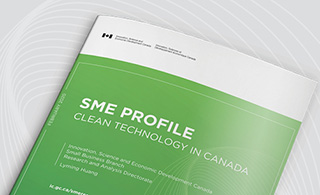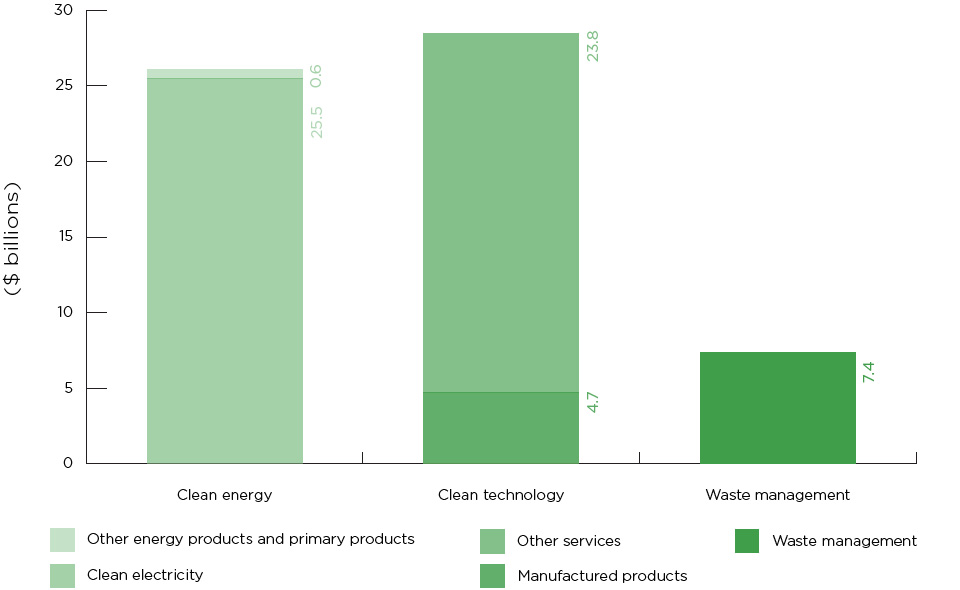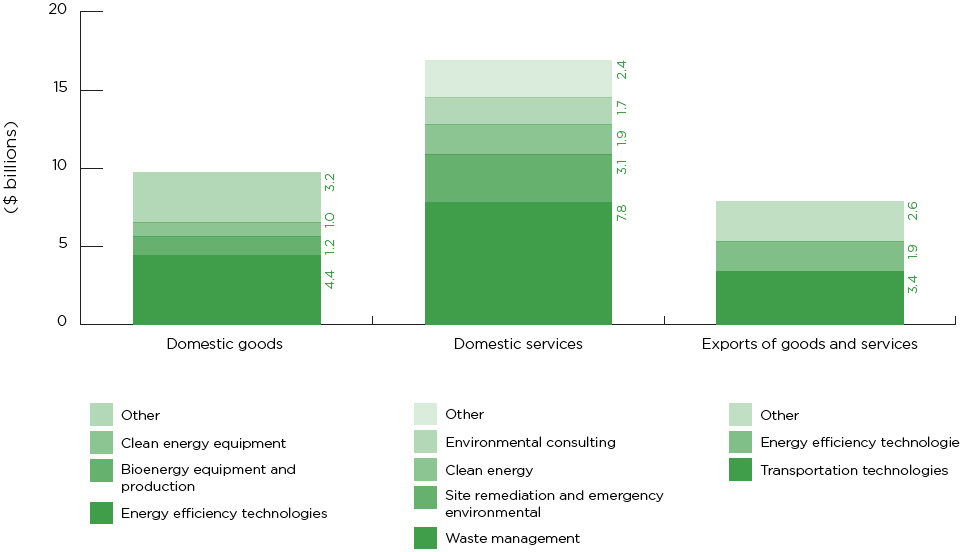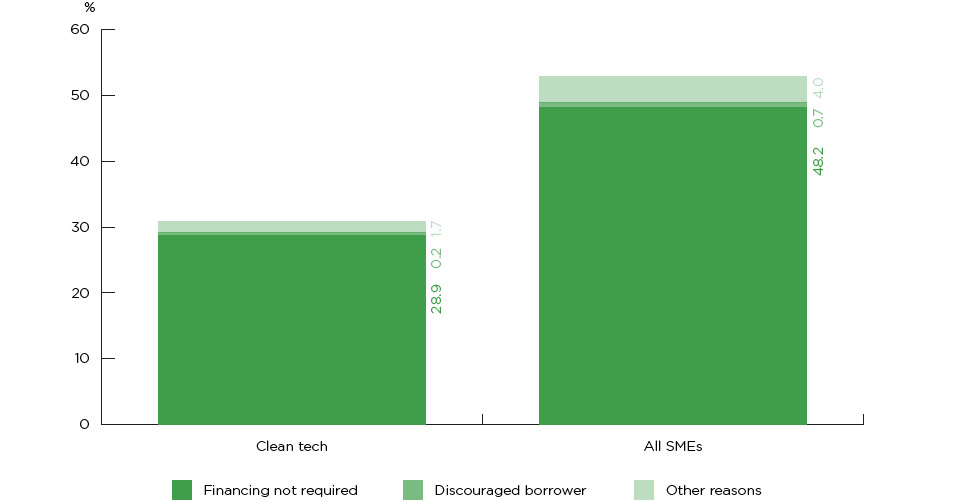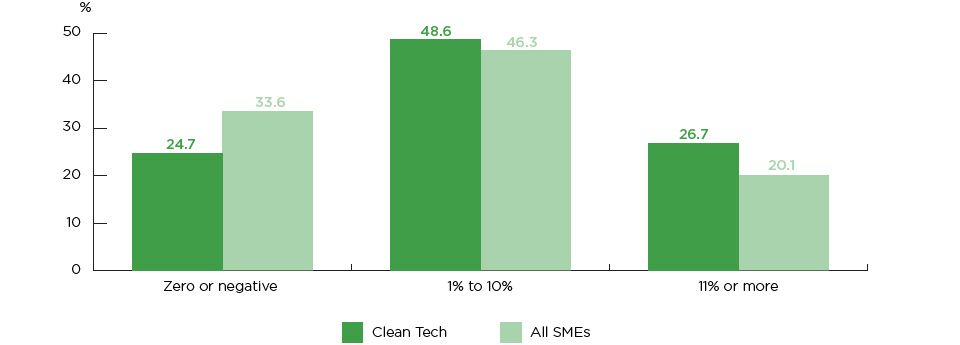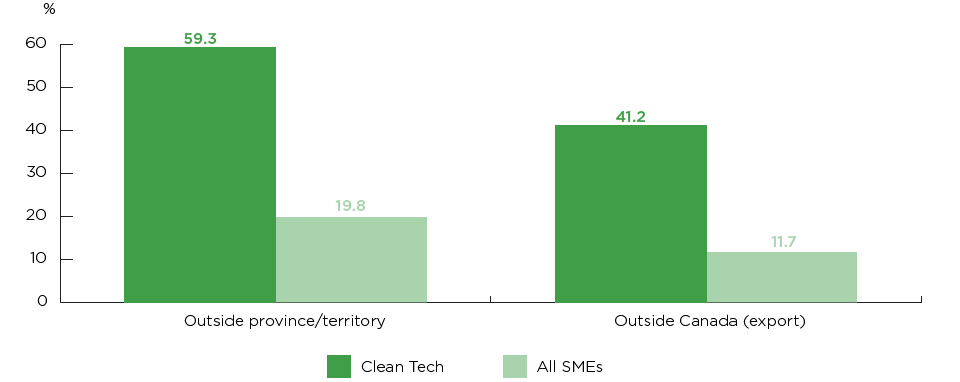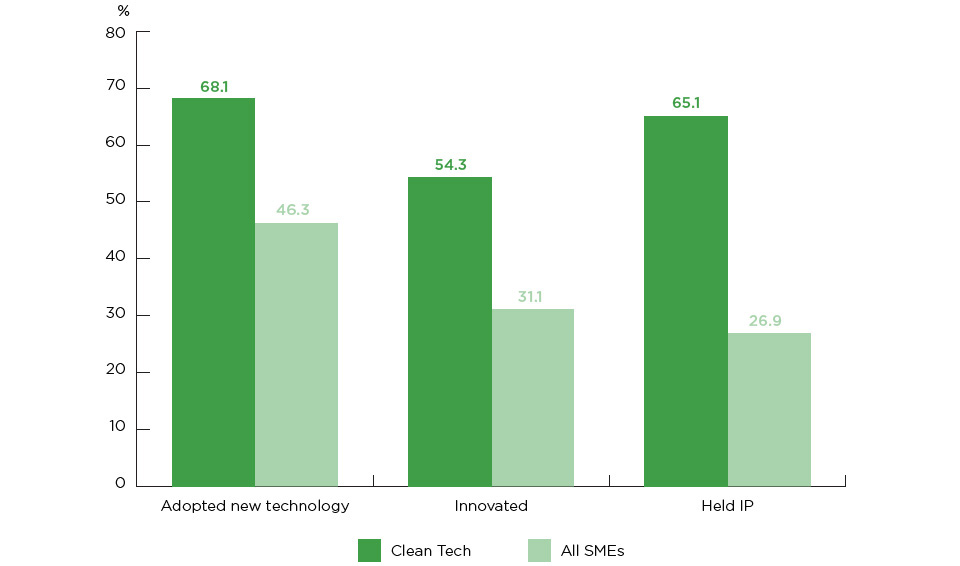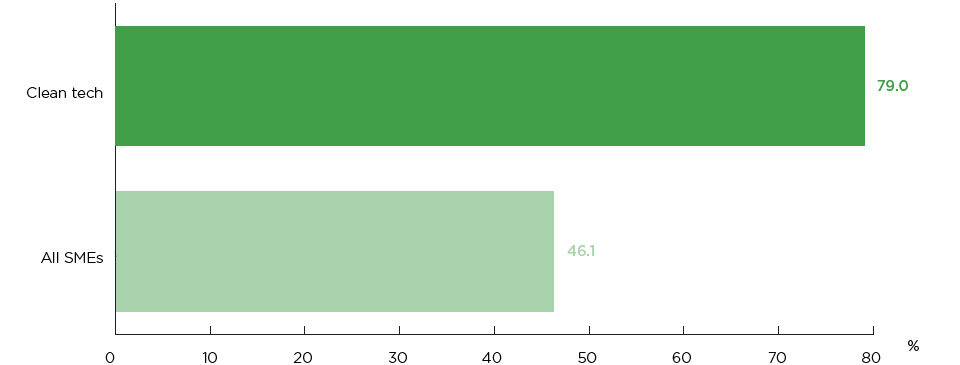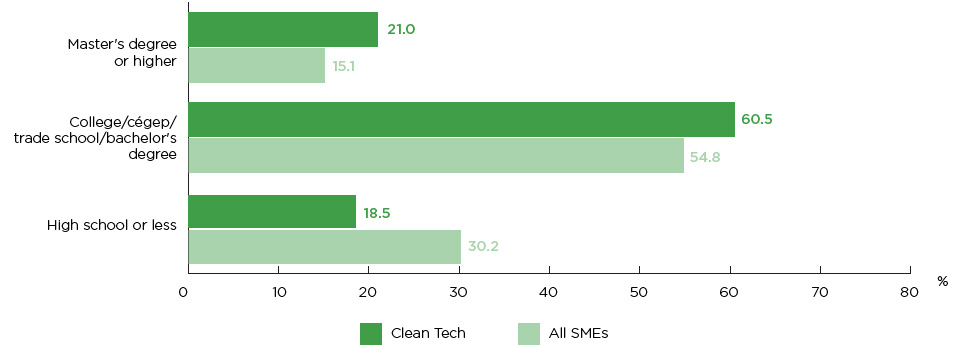This publication is also available online in HTML in print-ready format at ic.gc.ca/sbstatistics. Aussi offert en français sous le titre Profil des PME : Secteur des technologies propres au Canada – Février 2020.
To obtain a copy of this publication or an alternate format (Braille, large print, etc.), please fill out the Publication Request form or contact:
Web Services Centre Innovation,
Science and Economic Development Canada
C.D. Howe Building
235 Queen Street
Ottawa, ON K1A 0H5
Canada
Telephone (toll-free in Canada): 1-800-328-6189
Telephone (Ottawa): 613-954-5031
TTY (for hearing-impaired): 1-866-694-8389
Business hours: 8:30 a.m. to 5:00 p.m. (Eastern Time)
Email: ised@canada.ca
Permission to Reproduce
Except as otherwise specifically noted, the information in this publication may be reproduced, in part or in whole and by any means, without charge or further permission from the Department of Industry, provided that due diligence is exercised in ensuring the accuracy of the information reproduced; that the Department of Industry is identified as the source institution; and that the reproduction is not represented as an official version of the information reproduced, or as having been made in affiliation with, or with the endorsement of, the Department of Industry. For permission to reproduce the information in this publication for commercial purposes, please fill out the Application for Crown Copyright Clearance or contact the Web Services Centre (see contact information above).
Additional information:
Please note that in this publication, the masculine form refers to both women and men.
© Her Majesty the Queen in Right of Canada, as represented by the Minister of Industry, 2020
Innovation, Science and Economic Development Canada
Small Business Branch
Research and Analysis Directorate
Lyming Huang
Table of contents
Abstract
This report presents findings from the 2017 Survey on Financing and Growth of Small and Medium Enterprises to offer the first-ever snapshot of the financing and growth activities of clean technology (clean tech) small and medium-sized enterprises (SMEs) in Canada.
Results reveal an interesting profile of SMEs operating in the clean tech sector. In 2017, clean tech SMEs were larger and older than all SMEs, were more likely to seek financing and their financing requests were generally approved. Clean tech SMEs were high-performing firms, and grew, exported and innovated more often than all SMEs. They also exhibited high potential, tending to report both expansion intentions and growth expectations.
Finally, ownership of clean tech SMEs tended to be less diverse than that of all SMEs, while the primary decision makers of clean tech SMEs were better educated and had more experience than the primary decision makers of all SMEs.
1. Introduction
This report presents findings from the 2017 Survey on Financing and Growth of Small and Medium Enterprises to offer the first-ever snapshot of the financing and growth activities of clean technology (clean tech) small and medium-sized enterprises (SMEs) in Canada.
Section 2 outlines macroeconomic statistics on the environmental and clean technology sector in Canada. The sector, which in 2017 accounted for 3.1 percent of Canada's gross domestic product (GDP), is driven by clean electricity and waste management, activities that tend to fall under government. Businesses, including clean tech SMEs, play an important role in this sector, selling nearly $15 billion in environmental and clean technology goods and services in 2017.
Results from the 2017 Survey on Financing and Growth of Small and Medium Enterprises are presented in Section 3. These results compare firm characteristics, financing, growth activities and ownership of clean tech SMEs with those of all SMEs. In 2017, clean tech SMEs were larger and older than all SMEs, were more likely to seek financing and their financing requests were generally approved (as were the financing requests of all SMEs). Clean tech SMEs were high-performing firms, and grew, exported and innovated more often than all SMEs. They also exhibited high potential, tending to report both expansion intentions and growth expectations.
Finally, ownership of clean tech SMEs tended to be less diverse than that of all SMEs, while the primary decision makers of clean tech SMEs were better educated and had more experience than the primary decision makers of all SMEs.
2. Environmental and Clean Technology Sector
The environmental and clean technology products sector plays an important role in the Canadian economy. According to Statistics Canada's Environmental and Clean Technology Products Economic Account, environmental goods and services accounted for 3.1 percent ($61.9 billion) of Canada's GDP, 1.6 percent of jobs in Canada (282,000), 1.9 percent of Canadian exports and 1.7 percent of Canadian imports in 2017.Footnote 1
As shown in Figure 1, the largest contributors of environmental and clean technology towards Canada's GDP were clean technology (46 percent) and clean energy (42 percent). Waste management services comprised the remaining 12 percent.
Figure 1: Over half of environmental and clean technology GDP is clean electricity and waste management services
Environmental and clean technology GDP
The GDP breakdown indicates that government plays a significant role in the environmental and clean technology sector. For example, clean electricity and waste management services, which tend to fall under government, made up more than half of the sector's GDP.
Businesses, however, also play an important role, selling $34.7 billion in environmental and clean technology goods and services in 2017, according to Statistics Canada's Survey of Environmental Goods and Services.
Figure 2 breaks down this total into domestic goods ($9.8 billion), domestic services ($17.0 billion) and exports ($7.9 billion). The largest components of these categories were energy efficiency technologies ($4.4 billion), waste management services ($7.8 billion) and transportation technologies ($3.4 billion) respectively.
Figure 2: Environmental and clean technology businesses contribute to exports and domestic production
Environmental and clean technology sales by Canadian businesses
3. Clean Tech SMEs
The remainder of this report presents key findings on clean tech SMEs from the 2017 Survey on Financing and Growth of Small and Medium Enterprises. These newly developed statistics offer, for the first time, a picture of the characteristics, financing, growth activities and ownership demographics of clean tech SMEs in Canada. A description of the data and definitions used is given in Section 3.1.
3.1Data and Definitions
The 2017 Survey on Financing and Growth of Small and Medium Enterprises was designed to determine the types of financing used by SMEs, and to collect information on recent attempts by SMEs to obtain new financing. In addition, the survey gathers data on SMEs' growth, activities related to growth and business-owner characteristics.
The core target population for the survey was private sector, for-profit SMEs employing between 1 and 499 people and generating over $30,000 in annual revenues in 2017. The core target population of over 730,000 SMEs was stratified by geography, employment and industry, with random samples selected from these strata to generate representative estimates. The survey was conducted by Statistics Canada from February to June 2018. The core sample size was 17,323 SMEs, with a response rate of 59.7 percent. See the methodology report and questionnaire for further details.
The survey also oversampled clean technology businesses to produce statistics on clean tech SMEs. The clean tech sample size was 622 businesses, with a response rate of 70.4 percent, and was representative of clean tech SMEs, with over $750,000 in revenues, operating in industries covered by the 2017 Survey of Environmental Goods and Services, a mandatory survey that collects data on the sales of environmental and clean technology goods and services.
Clean technology is defined as any process, good or service that reduces environmental impacts through:
- environmental protection activities that prevent, reduce or eliminate pollution or any other degradation of the environment;
- resource management activities that result in more efficient use of natural resources, thus safeguarding against their depletion; or
- the use of goods that have been adapted to be significantly less energy or resource intensive than the industry standard.
Examples of goods and services covered by the Survey of Environmental Goods and Services include renewable energy production, management of non-hazardous waste and energy efficiency services. Further details on the clean tech sample are provided in the Appendix.
The survey results on clean tech SMEs should be considered experimental. Notably, some of the differences between clean tech SMEs and all SMEs described below may be attributable, in part, to differences in sample exclusions.Footnote 2
3.2Firm Characteristics
In 2017, clean tech SMEs were large and well-established businesses, tending to have more employees and to have been in operation longer than all SMEs.
Clean tech SMEs were much more likely than all SMEs to be medium-sized, with 8 percent having between 100 and 499 employees and 38 percent having between 20 and 99 employees, compared with 2 percent and 11 percent of all SMEs respectively (Figure 3). Likewise, there were very few micro-sized clean tech firms, with 10 percent of clean tech SMEs having between 1 and 4 employees. By contrast, over half of all SMEs were in this firm size group.
Figure 3: Clean tech firms are larger
Firm size (number of employees) (% of businesses)
Based upon clean tech firm size, and given that newer firms tend to be smaller, it is not surprising that clean tech SMEs were also more likely to be older. Figure 4 shows that 52 percent of clean tech SMEs had been in operation more than 20 years, compared with 31 percent of all SMEs. Similarly, clean tech SMEs were less likely to be younger, with 18 percent in operation for 10 years or less, compared with 43 percent of all SMEs.
Figure 4: Clean tech firms are older
Firm age (% of businesses)
3.3Financing
Clean tech SMEs were more likely to request financing than all SMEs. When clean tech SMEs sought financing, their requests tended to be approved, as were the financing requests of SMEs in general. Furthermore, while all SMEs were unlikely to face barriers to accessing financing, clean tech SMEs may have accessed financing even more readily than all SMEs.
In 2017, clean tech SMEs tended to seek external financing more often than all SMEs, with 69 percent of clean tech enterprises seeking external financing (of any type), compared with 47 percent of all SMEs (Figure 5). Thirty-eight percent of clean tech firms requested debt financing, compared with 26 percent of all SMEs. Likewise, clean tech SMEs were more likely to request government grants, subsidies and non-repayable contributions, with 11 percent seeking government financing compared with 4 percent of all SMEs. Indeed, clean tech SMEs were more likely to seek all other types of external financing, including trade credit, lease financing and equity financing, than all SMEs.
Figure 5: Clean tech SMEs are more likely to seek financing
Requested financing (% of businesses)
Nearly all debt financing requests made by all SMEs were approved in 2017. However, clean tech SMEs may have accessed financing even more readily. In particular, 92 percent of debt financing requests made by clean tech SMEs were approved, while the ratio of the amount of financing authorized to the amount of financing requested was 97 percent (Figure 6). By comparison, the debt financing approval rate for all SMEs was 89 percent, while the ratio of the amount of financing authorized to the amount of financing requested was 93 percent.
Figure 6: SME financing is typically approved
Approval rate (% of businesses), and share of amount of financing authorized to requested (%)
Clean tech SMEs, similar to all SMEs, were unlikely to report difficulties in accessing financing in 2017. Of the 31 percent of clean tech firms that did not request external financing, 94 percent reported that financing was not required (Figure 7). By comparison, of the 53 percent of all SMEs that did not request external financing, 91 percent reported that financing was not required.
Figure 7: SMEs are rarely discouraged borrowers
Reasons for not requesting financing (% of businesses)
Furthermore, less than 1 percent of all SMEs and of clean tech SMEs did not request financing because they did not think their request would be approved (i.e., discouraged borrowers).Footnote 3 Finally, only 8 percent of all SMEs and 7 percent of clean tech SMEs considered obtaining financing to be a major obstacle to growth.
3.4Growth Activities
In 2017, clean tech SMEs were high-performing and high-potential businesses. Clean tech SMEs were more likely than all SMEs to report average yearly growth of 11 percent or more in their previous three years of operation (from 2015 to 2017), with 27 percent of clean tech SMEs reporting average annual growth in sales or revenue of 11 percent or more, compared with 20 percent of all SMEs (Figure 8). Clean tech SMEs were also more likely to report positive growth, with 75 percent reporting positive growth (i.e., 1 percent or more) from 2015 to 2017, compared with 66 percent of all SMEs.
Figure 8: Clean tech SMEs report higher growth
Average yearly growth in sales/revenue from 2015 to 2017 (% of businesses)
Clean tech SMEs were also more likely than all SMEs to export and engage in other international business activities, and to innovate, adopt new technology and hold intellectual property (IP). Clean tech SMEs also tended to report expansion intentions and growth expectations more often than all SMEs.
More clean tech SMEs sold nationally or internationally than all SMEs. Fifty-nine percent of clean tech SMEs sold to other provinces or territories, and 41 percent of clean tech firms exported (Figure 9). By contrast, 20 percent of all SMEs sold outside of their own province or territory, while 12 percent sold internationally.
Figure 9: Clean tech SMEs are national and international businesses
Sales destination (% of businesses)
Furthermore, clean tech SMEs were more likely to engage in other international business activities in 2017. For example, 50 percent and 15 percent of clean tech SMEs imported production inputs and had products manufactured abroad, respectively, compared with 12 percent and 4 percent of all SMEs.
Clean tech SMEs were also more likely than all SMEs to innovate, adopt new technology and hold IP in 2017. Sixty-eight percent of clean tech SMEs adopted at least one new technology, such as cloud computing or data analytics, over the past three years, compared with 46 percent of all SMEs (Figure 10).
Figure 10: Clean tech SMEs are innovative and cutting-edge
Technology adoption, innovation and IP holdings (% of businesses)
Fifty-four percent of clean tech SMEs introduced at least one type of innovation within the previous three years, compared with 31 percent of all SMEs. Clean tech enterprises were also more likely to have introduced all types of innovation — product, process, organizational and marketing innovations.
In 2017, 65 percent of clean tech SMEs held at least one type of IP, compared with 27 percent of all SMEs. Clean tech firms were also more likely to hold all types of IP, including formal IP (e.g., patents) and informal IP (e.g., trade secrets).
Finally, clean tech SMEs expressed expansion intentions and growth expectations. In 2017, 79 percent of clean tech SMEs expressed intentions to expand into new markets over the period from 2018 to 2020, compared with 46 percent of all SMEs (Figure 11). Clean tech SMEs were also much more likely than all SMEs to report intentions to expand into new local, domestic and international markets. Likewise, clean tech SMEs were more likely than all SMEs to report positive growth expectations between 2018 and 2020.
Figure 11: Clean tech SMEs look to expand
Intend to expand into new markets between 2018 and 2020 (% of businesses)
3.5 Ownership
Broadly speaking, ownership of clean tech SMEs was less diverse than that of all SMEs, with majority ownership of clean tech SMEs less likely to be comprised of people in under-represented demographics, such as women or visible minorities. Clean tech SMEs also tended to have primary decision makers who are better educated and more experienced than the primary decision makers of all SMEs.
In 2017, clean tech SMEs tended to be majority owned by men, with 81 percent majority owned by men, compared with 64 percent of all SMEs (Figure 12). Clean tech SMEs were also less likely to be majority owned by visible minorities, Aboriginal personsFootnote 4 and person(s) with a disability.
Similarly, 18 percent of clean tech SMEs had primary decision makers who were born outside of Canada, compared with 25 percent of all SMEs.
Figure 12: Clean tech SME ownership is less diverse
Majority ownership demographics (% of businesses)
Clean tech SME primary decision makers were also more likely to have attained degrees at the post-secondary or graduate level. As shown in Figure 13, 21 percent of clean tech SMEs had primary decision makers with a master's degree or higher, while the primary decision makers of 61 percent of clean tech SMEs held college, cégep or trade school diplomas, or a bachelor's degree. By contrast, the primary decision makers of 15 percent and 55 percent of all SMEs held a master's degree or higher and college, cégep or trade school diplomas, or a bachelor's degree respectively.
Figure 13: Clean tech SME primary decision makers are well-educated
Highest level of education attained by primary decision maker (% of businesses)
The primary decision makers of clean tech SMEs tended to have more experience than those ofall SMEs. In 2017, 84 percent of clean tech SMEs had primary decision makers with more than10 years of experience in managing or owning a business, compared with 72 percent of all SMEs(Figure 14). Clean tech SMEs were also less likely to have primary decision makers with fewer than10 years of experience. Correspondingly, the primary decision makers of clean tech SMEs weremore likely to be 50 years of age or older, compared with all SMEs.
Figure 14: Clean tech SME primary decision makers are experienced
Primary decision maker years of experience (% of businesses)
4 Conclusions
This report offers a snapshot of the financing and growth activities of clean tech SMEs in Canada. The environmental and clean technology sector plays an important role in the Canadian economy, contributing to GDP, jobs, exports and imports.
Detailed statistics are presented on clean tech SMEs operating within this sector in 2017. Results, based upon the Survey on Financing and Growth of Small and Medium Enterprises, show that clean tech SMEs were larger and older than all SMEs, were more likely to seek financing and their financing requests were generally approved (as were the financing requests of all SMEs). Clean tech SMEs were high-performing firms, tending to grow, export and innovate more often than all SMEs. They were also more likely to seek to expand and to expect to grow.
Finally, ownership of clean tech SMEs tended to be less diverse than that of all SMEs, while the primary decision makers of clean tech SMEs were better educated and had more experience than the primary decision makers of all SMEs.
Appendix: Detailed Description of the Clean Tech Sample
Businesses identified as clean technology firms by the 2017 Survey of Environmental Goods and Services, a mandatory Statistics Canada survey, comprised the sampling frame for the Survey on Financing and Growth of Small and Medium Enterprises clean tech sample. Respondents to the Survey of Environmental Goods and Services operated in the following North American Industry Classification System (NAICS) industries:
| NAICS code | NAICS title |
|---|---|
| 115 | Support activities for agriculture and forestry |
| 211 | Oil and gas extraction |
| 212 | Mining and quarrying (except oil and gas) |
| 23 | Construction |
| 311 | Food manufacturing |
| 321 | Wood product manufacturing |
| 324 | Petroleum and coal product manufacturing |
| 325 | Chemical manufacturing |
| 326 | Plastics and rubber products manufacturing |
| 327 | Non-metallic mineral product manufacturing |
| 332 | Fabricated metal product manufacturing |
| 333 | Machinery manufacturing |
| 334 | Computer and electronic product manufacturing |
| 335 | Electrical equipment, appliance and component manufacturing |
| 336 | Transportation equipment manufacturing |
| 339 | Miscellaneous manufacturing |
| 412 | Petroleum and petroleum products merchant wholesalers |
| 415 | Motor vehicle and motor vehicle parts and accessories merchant wholesalers |
| 416 | Building material and supplies merchant wholesalers |
| 417 | Machinery, equipment and supplies merchant wholesalers |
| 418 | Miscellaneous merchant wholesalers |
| 419 | Business-to-business electronic markets, and agents and brokers |
| 5112 | Software publishers |
| 518 | Data processing, hosting and related services |
| 541 | Professional, scientific, and technical services |
| 5416 | Management, scientific and technical consulting services |
| 56 | Administrative and support, waste management and remediation services |
| 811 | Repair and maintenance |
The questionnaire used by the Survey of Environmental Goods and Services covers the following categories of clean technology goods and services:
|
|
|
|
|
|
|
|
|
|
|
|
|
|
|
|
|
|
|
|
|
|
For more details, consult the Survey of Environmental Goods and Services page.

